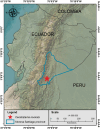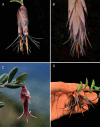A new species of Ceratostema (Ericaceae) with nearly tubular leaves from the Cordillera del Cóndor, Ecuador
- PMID: 40822046
- PMCID: PMC12355187
- DOI: 10.3897/phytokeys.261.156555
A new species of Ceratostema (Ericaceae) with nearly tubular leaves from the Cordillera del Cóndor, Ecuador
Abstract
A new species of Ceratostema from the Cordillera del Cóndor in Ecuador is described and illustrated. Ceratostemarevoluta is distinguished by its nearly tubular leaves with revolute margins, pulvinate petioles, reddish flowers with white base and brownish to black lobes, short, complanate pedicel with carinate bracteoles appressed to the base and calyx lobes appressed to the corolla and overlapping each other below the middle. The taxonomic similarities of the new species are discussed and information about its distribution, habitat and conservation is provided.
Keywords: Morona Santiago; Northern Andes; south-eastern Ecuador; taxonomy.
Marco M. Jiménez, Henry X. Garzón-Suárez, Gabriel A. Iturralde.
Conflict of interest statement
The authors declare that there is no conflict of interest regarding the publication of this article.
Figures



References
-
- Christenhusz MJ, Byng JW. (2016) The number of known plant species in the world and its annual increase. Phytotaxa 261(3): 201–217. 10.11646/phytotaxa.261.3.1 - DOI
-
- Cornejo X, Pedraza-Peñalosa P. (2019) Sphyrospermumgrandiflorum (Ericaceae: Vaccinieae): a new epiphytic shrub from south eastern Ecuador. Phytotaxa 409(2): 66–70. 10.11646/phytotaxa.409.2.2 - DOI
-
- Cornejo X, Luteyn JL. (2024) Three new epiphytic species and a new variety in Ceratostema (Ericaceae: Vaccinieae) from southeastern Ecuador. Journal of the Botanical Research Institute of Texas 18(2): 321–332. 10.17348/jbrit.v18.i2.1369 - DOI
-
- Cornejo X, Tello-Hidalgo G, Luteyn JL. (2024) Ceratostemaloucianae and Disterigmachriscanadayi (Ericaceae: Vaccinieae)—new epiphytic species from eastern Ecuador. Journal of the Botanical Research Institute of Texas 18(1): 87–93. 10.17348/jbrit.v18.i1.1340 - DOI
LinkOut - more resources
Full Text Sources
